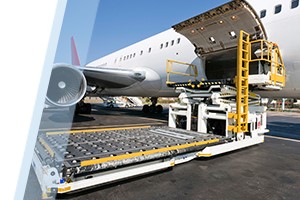
Air Freight: Learning the Basics to Optimize Your Global Supply Chain
This content was updated in June 2019
As the name implies, air freight can be defined as: The transportation of goods by aircraft.
Top benefits of air freight shipping
Shippers often choose air freight as their transportation method for key reasons:
- Speed: Air freight is usually the fastest way to get goods to their destination.
- Reliability: Despite occasional weather delays, air freight has the lowest possibility of impediment.
- Lower inventory carrying costs: Faster deliveries mean your freight spends less time in the warehouse.
- Opportunity to capture market share: Ability to fit into tight deadlines can be a winning sales strategy.
Why doesn’t everyone choose air service?
Air freight can be more expensive than other modes of transportation. When considering the cost of a modal shift to air cargo, keep in mind that your freight costs are only one component of the equation. There are times when other benefits within your supply chain may offset the possibility of higher freight costs.
It’s critical to remember that shipping by air is not a one-size-fits-all option. Therefore, any strategy you implement should be tailored to your needs, not anyone else’s. If done successfully, incorporating the right air shipping strategy into your multi-modal, global supply chain will not only help reduce costs, but it will also promote efficiency.
Three primary air freight options
The three primary air shipping options are next flight out, consolidated, and deferred. Any one (or all) may work for your business. There are other options to consider as well, like air charter, which can help secure the capacity you need and allows you to use an exclusive aircraft to meet any unique requirements.
1. Next flight out
Definition: As the name suggests, your air freight is shipped as soon as a flight is available.
Characteristics: Sometimes referred to as expedited, this is the fastest air cargo shipping option, but is also often the most costly. Expedited air requires a provider with the resources to locate capacity at the last minute to ensure your timelines are met.
2. Consolidated shipping
Definition: Providers combine your air freight with the cargo of several other shippers prior. View this infographic for an overview of the consolidation process on a global level.
Characteristics: Consolidated air shipments move on a set schedule. By transporting at set times and with a larger shipment of goods, providers are often able to secure better rates. The key to consolidating air cargo is choosing a provider like C.H. Robinson that as the scale to consolidate your air and ocean freight with others for better cost efficiency. A small provider may not work with enough companies to have regular shipments of consolidated air freight, which could lead to delays or added costs.
3. Deferred
Definition: Postponing the shipment of your lower priority freight until there is space available on the aircraft.
Characteristics: Often this type of air shipment still operates on a regular schedule. With this type of service, shippers simply defer their air cargo to the third, fourth, or fifth business day. This type of air cargo often offers the greatest cost savings due to the potential for longer transit times.
Final thoughts
These basic details of air freight certainly do not cover everything you need to know about incorporating air cargo into your supply chain.
For a deeper understanding of air freight and information on how to incorporate it into your supply chain, read our white paper, Optimizing Your Supply Chain with Air Cargo, which takes a deeper look at the many facets and benefits of air freight.
Still looking for the right air cargo service? Connect with one of our air shipping experts.



